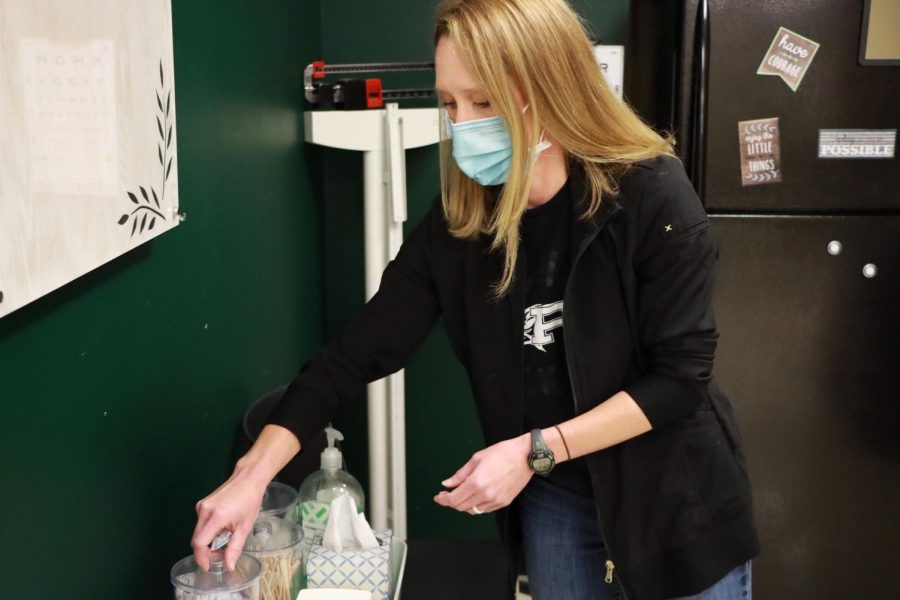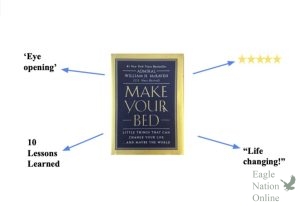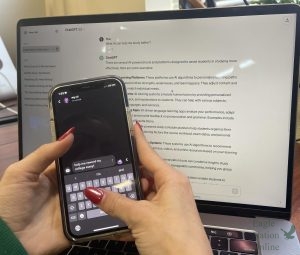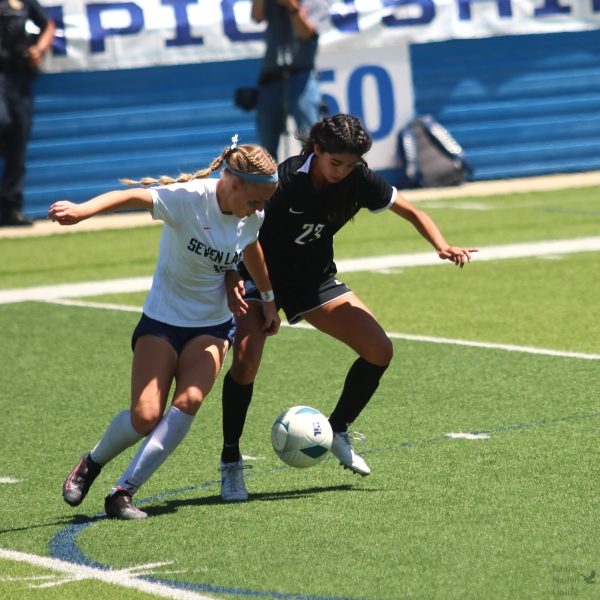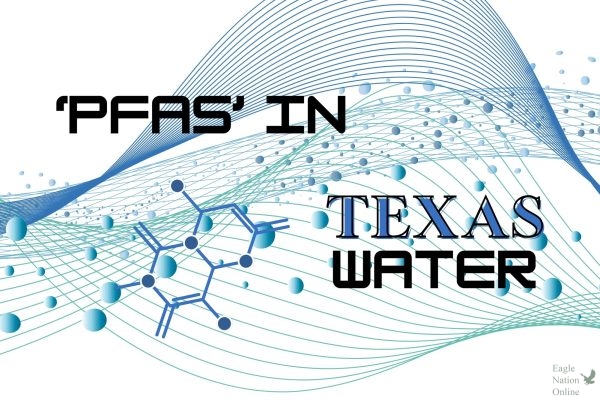Analysis: Schools, stores, medics adapt to evolving COVID-19 measures
Organizing the cart in the clinic, Shanelle Stewart demonstrates just one of her tasks as the high school nurse. Because of the uniqueness of this year with the coronavirus, Stewart has had to constantly check for changing policies of how to manage COVID-19 cases at the highschool. “As of this week, CDC changed their guidelines for close contact exposure,” Ms. Stewart said. “It used to be a 14 day restriction, but now the CDC is saying the incubation period is shorter than before, so you’ll see it between 7-10 days, and so the 7-10 day restriction should be in place here in a few days.”
December 7, 2020
COVID-19 has wormed its way into the fabric of everyday life — long gone are the days when people thought it would be here for only a few weeks. Even now, it’s managing to disrupt the tenets of American society, from box store shopping to education.
Because of the uniqueness of this year with the coronavirus, school nurse Shanelle Stewart has had to constantly check for changing policies with the Centers for Disease Control, concerning how to manage COVID-19 cases at the high school.
“As of this week, CDC changed their guidelines for close contact exposure,” Stewart said. “It used to be a 14-day restriction, but now the CDC is saying the incubation period is shorter than before. So, you’ll see it between 7-10 days, and so the 7-10 day restriction should be in place here in a few days.”
New update by the CDC released Dec. 2, 2020
According to new measures published on the CDC website Dec. 2, 2020, “Quarantine can end after Day 10 without testing and if no symptoms have been reported during daily monitoring. With this strategy, residual post-quarantine transmission risk is estimated to be about 1% with an upper limit of about 10%. Reducing the length of quarantine will reduce the burden and may increase community compliance.” This policy should be put into action in schools throughout the U.S. within a week.
Schools
Nearly 40 Texas schools have asked to halt their in-person learning for five-plus days due to rising COVID-19 cases. Prosper ISD continues to offer a choice to students and parents for their mode of instruction along with a COVID-19 instructional update website. According to their website, PISD updates its COVID-19 dashboard “at least weekly”. The total number of in-person cases as of Dec. 4 included 13 out of 13,365 students who receive in-person instruction.
Austin ISD is now offering free, drive-through rapid COVID-19 testing outside the campus in central Austin. AISD updates its COVID-19 dashboard every weekday at 1 p.m. When the district updated the numbers the afternoon of Monday, Nov. 30, Austin High’s new exposures jumped from 0 to 307. Rural schools have also been hit by the effects of rising COVID-19 cases. Blanco ISD went from one COVID-19 case in 12 weeks, to more than 10 in the last week. Around 20 staff members had to quarantine, which took its toll in a small district with about 1,000 students.
Box Stores
Walmart is again counting the number of customers at its stores as the U.S. continues to break COVID-19 case records, with Texas currently having the highest amount of coronavirus cases in the United States, at more than 1 million. According to data from the COVID-19 Tracking Project, more than 68,500 Texans are hospitalized with the virus across the country, more than at any other point during the pandemic. “We know from months of metering data in our stores that the vast majority of the time our stores didn’t reach our self-imposed 20% metering capacity,” said Walmart spokesperson Kory Lundberg. “Out of an abundance of caution, we have resumed counting the number of people entering and leaving our stores.”
Collin County Updates
Governor Greg Abbott and the Texas Department of State Health Services (DSHS) have announced how the COVID-19 vaccine will be distributed, which may be as early as this December. These principles have been established by the Expert Vaccine Allocation Panel (EVAP), created to make recommendations on vaccine allocation decisions, including vaccine access to vulnerable populations and critical state resources.
“These guiding principles established by the Expert Vaccine Allocation Panel will ensure that the State of Texas swiftly distributes the COVID-19 vaccine to Texans who voluntarily choose to be immunized,” Governor Abbott said. “This foundation for the allocation process will help us mitigate the spread of COVID-19 in our communities, protect the most vulnerable Texans, and safeguard crucial state resources.”
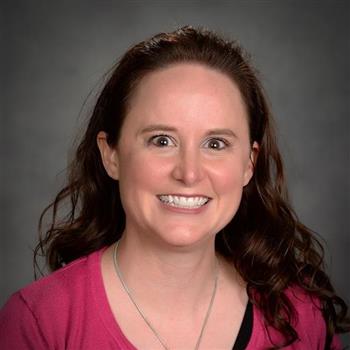
It has been an incredibly busy year. While I have worked several significant communicable disease situations in years past, the coronavirus pandemic has been the most widespread in impact and effect that I have led through. We are still taking care of student and staff acute and chronic health needs, caring for injuries, conducting health screenings, making referrals, providing community resources for care, providing health education, monitoring immunizations, and so much more — it’s just that coronavirus has taken the limelight right now and demands much of our time to help keep it in check within our campuses.
— Becky Geise, Prosper ISD Director of Health Services
Texas will initially allocate COVID-19 vaccines based on the following criteria:
- Protecting health care workers who are crucial to maintaining the health care infrastructure for all who need it.
- Protecting frontline workers who are at greater risk of contracting COVID-19.
- Protecting vulnerable populations who are at greater risk of disease and death if they contract COVID-19.
- Balancing unequal access due to factors such as demographics, poverty, insurance status and geography.
- Data-driven allocations using the best available scientific evidence and epidemiology at the time, allowing for flexibility for local conditions.
- Geographic diversity through a balanced approach that considers access in urban and rural communities and in affected ZIP codes.
- Transparency through seeking public feedback.
Dallas County Updates
“The rate of community spread has our local health authority and our regional hospital administrators concerned that we are quickly approaching caseloads that will be unbearable for our facilities and personally catastrophic for our families,” Jenkins said.
Dallas County’s public health committee has made a number of recommendations they believe would help slow the spread of the virus, including these: putting in place a stronger and more expansive mask order for Dallas County, maintaining current bar closures in the county, and closing “loopholes” allowing bars to open if they serve food, a policy created by the TABC. Committee members also want the governor to close all dining inside restaurants, permitting only drive-through, take-out, and curbside pick-up, and allowing outside dining only when six feet of separation between parties is possible.
Back Home
According to Becky Geise, Director of Health Services for the district, COVID-19 prevention measures will continue — without neglecting other health-related obligations.
“It has been an incredibly busy year,” Geise said. “While I have worked several significant communicable disease situations in years past, the coronavirus pandemic has been the most widespread in impact and effect that I have led through. The coronavirus has taken the limelight right now and demands much of our time to help keep it in check within our campuses.”


